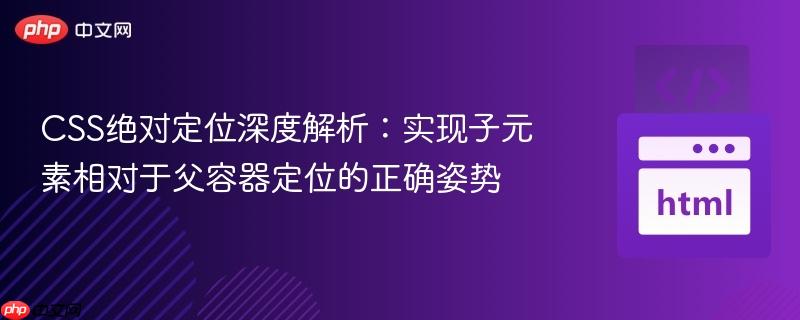
在使用css进行布局时,position: absolute 是一个强大而常用的属性,它允许我们将元素精确地放置在页面上的任何位置。然而,一个常见的困惑是,当一个子元素被设置为 position: absolute 时,它似乎没有按照预期相对于其直接父容器进行定位,反而“跳出”了父容器,相对于 <body> 或 <html> 元素定位。
这并非错误,而是对 position: absolute 工作原理的误解。根据CSS规范,一个 position: absolute 的元素会相对于其最近的已定位祖先元素进行定位。这里的“已定位祖先元素”指的是 position 属性值不为默认 static 的任何祖先元素(即 position: relative、position: absolute、position: fixed 或 position: sticky)。
如果一个 position: absolute 的元素没有找到任何已定位的祖先元素,那么它将回退到相对于初始包含块(通常是 <html> 元素,也就是整个浏览器视口)进行定位。这就是为什么有时会看到绝对定位的元素“跑到”页面底部或顶部的原因。
让我们通过一个具体的代码示例来演示这个问题。假设我们有一个父容器 #container,里面包含一个子元素 #bottomBox,我们希望 #bottomBox 能够固定在 #container 的底部。
<div id="container">
<div id="bottomBox"></div>
</div>以及相应的CSS样式:
立即学习“前端免费学习笔记(深入)”;
#container {
margin: auto;
margin-top: 10px;
width: 90%;
aspect-ratio: 2 / 1;
background-color: green;
/* 缺少 position 属性,默认为 static */
}
#bottomBox {
width: 15%;
aspect-ratio: 2 / 1;
position: absolute; /* 绝对定位 */
left: 42.5%;
bottom: 0; /* 期望相对于 #container 底部 */
background-color: black;
}在这种情况下,#bottomBox 将不会相对于 #container 的底部定位。因为 #container 元素没有设置任何 position 属性,其默认值是 static。因此,#bottomBox 在其祖先链中找不到已定位的元素,最终会相对于 <html> 元素进行定位,导致它出现在整个页面的底部,而不是 #container 的底部。
解决这个问题的关键在于,为 position: absolute 元素的父容器设置一个非 static 的定位属性。最常用且推荐的做法是使用 position: relative。
当父容器被设置为 position: relative 时,它自身仍然会保留在正常的文档流中,不会脱离文档流,也不会影响其在页面中的位置。但它会创建一个新的定位上下文,使其内部的 position: absolute 子元素能够以它为参照物进行定位。
修改后的CSS代码如下:
#container {
margin: auto;
margin-top: 10px;
width: 90%;
aspect-ratio: 2 / 1;
background-color: green;
position: relative; /* 关键改动:设置为 relative */
}
#bottomBox {
width: 15%;
aspect-ratio: 2 / 1;
position: absolute;
left: 42.5%;
bottom: 0; /* 现在会相对于 #container 底部 */
background-color: black;
}通过添加 position: relative 到 #container,#bottomBox 现在将正确地相对于其父容器 #container 的底部进行定位。
以下是包含修复后的完整HTML和CSS代码:
<!DOCTYPE html>
<html lang="en">
<head>
<title>Absolute Positioning Corrected</title>
<style>
* {
margin: 0px;
padding: 0px;
box-sizing: border-box; /* 推荐添加,避免盒模型问题 */
}
body {
min-height: 200vh; /* 增加 body 高度以观察效果 */
background-color: lightgray;
}
#container {
margin: auto;
margin-top: 50px; /* 增加顶部边距,使效果更明显 */
width: 80%;
max-width: 600px;
aspect-ratio: 2 / 1;
background-color: green;
position: relative; /* 关键:使子元素能相对于它定位 */
display: flex; /* 保持原有的 flex 布局 */
justify-content: center;
align-items: center;
overflow: hidden; /* 防止子元素溢出时影响布局 */
}
#blueBox, #redBox, #topBox {
/* 示例中其他盒子的样式,为保持完整性 */
position: absolute; /* 这些也需要已定位的父元素 */
}
#blueBox {
width: 20%;
height: 50%;
background-color: blue;
left: 5%;
top: 25%;
}
#redBox {
width: 20%;
height: 50%;
background-color: red;
right: 5%;
top: 25%;
}
#topBox {
width: 15%;
aspect-ratio: 2 / 1;
left: 50%;
transform: translateX(-50%); /* 水平居中 */
top: 10%;
background-color: grey;
}
#bottomBox {
width: 15%;
aspect-ratio: 2 / 1;
position: absolute; /* 绝对定位 */
left: 50%;
transform: translateX(-50%); /* 水平居中 */
bottom: 0; /* 相对于 #container 底部 */
background-color: black;
}
</style>
</head>
<body>
<div id="container">
<div id="blueBox"></div>
<div id="redBox"></div>
<div id="topBox"></div>
<div id="bottomBox"></div>
</div>
<!-- 增加一些内容,确保页面可以滚动,以验证绝对定位效果 -->
<div style="height: 1000px; background-color: #f0f0f0; margin-top: 20px; padding: 20px;">
<p>页面滚动内容...</p>
<p>确保 #container 和 #bottomBox 的相对位置在滚动时保持不变。</p>
</div>
</body>
</html>掌握 position: absolute 的正确使用方式对于创建复杂而精确的CSS布局至关重要。核心原则是:为了让一个绝对定位的子元素能够相对于其父容器定位,该父容器必须被设置为一个非 static 的 position 值。 在大多数情况下,将父容器设置为 position: relative 是最简洁有效的解决方案,因为它既提供了定位参照,又不会干扰父容器在文档流中的正常表现。理解并应用这一原则,将帮助您避免常见的布局问题,实现更灵活和可控的网页设计。
以上就是CSS绝对定位深度解析:实现子元素相对于父容器定位的正确姿势的详细内容,更多请关注php中文网其它相关文章!

每个人都需要一台速度更快、更稳定的 PC。随着时间的推移,垃圾文件、旧注册表数据和不必要的后台进程会占用资源并降低性能。幸运的是,许多工具可以让 Windows 保持平稳运行。

Copyright 2014-2025 https://www.php.cn/ All Rights Reserved | php.cn | 湘ICP备2023035733号